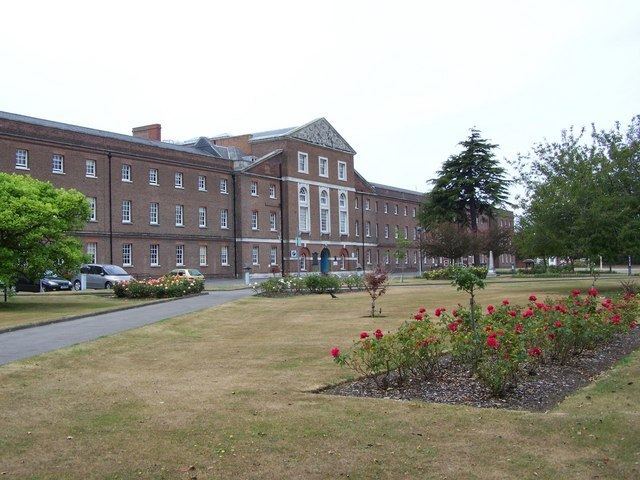Care system Public NHS Beds Up to 350 Closed 2009 | Hospital type Military / NHS Founded 1753 Phone +44 23 9252 3840 | |
 | ||
Address Haslar Rd, Gosport PO12 2AA, UK | ||
Exploring the abandoned royal hospital haslar dec 2016
Founded in the reign of King George I, the Royal Hospital Haslar in Gosport, Hampshire, was one of several hospitals serving the Portsmouth Urban Area, but had previously been the country's foremost – and ultimately last – military hospital. Its military status was withdrawn in 2007, and those military personnel remaining joined the Ministry of Defence Hospital Unit (MDHU Portsmouth) at Queen Alexandra Hospital in Cosham, Portsmouth. In the summer of 2009, all remaining (civilian) medical services at Haslar were relocated to the Queen Alexandra Hospital, and the site was subsequently sold.
Contents
- Exploring the abandoned royal hospital haslar dec 2016
- Royal hospital haslar urbex
- History
- The site
- The last military run ward
- Current Use
- References
The Royal Military Hospital Haslar had a number of notable specialist medical facilities, including a decompression chamber and a zymotic isolation ward.
Royal hospital haslar urbex
History
The Royal Hospital Haslar was designed by Theodore Jacobsen and built between 1745 and 1761. The site opened as a Royal Naval Hospital in 1754. On completion it was the largest brick building in Europe, and the largest hospital in England. Building works cost more than £100,000, nearly double the cost of the Admiralty headquarters in London.
Patients usually arrived by boat (it was not until 1795 that a bridge was built over Haslar Creek, providing a direct link to Gosport). The high brick walls and railings surrounding the site were designed to stop patients from going absent without leave. Dr James Lind (1716–1794), a leading physician at Haslar from 1758 till 1785, played a major part in discovering a cure for scurvy, not least through his pioneering use of a double blind methodology with Vitamin C supplements (limes). The hospital included an asylum for sailors with psychiatric disorders, and an early superintending psychiatrist was the phrenologist, Dr James Scott (1785–1859), a member of the influential Edinburgh Phrenological Society.
In 1902 the hospital became known as the Royal Naval Hospital Haslar (abbreviated to RNH Haslar).
In the 1940s, RNH Haslar set up the country's first blood bank to treat wounded soldiers from the Second World War.
In 1966, the remit of the hospital expanded to serve all three services – the Royal Navy, Army and Royal Air Force, after which time, it became known as the Royal Military Hospital Haslar.
In 1996 the hospital again became known as the Royal Hospital Haslar.
In 2001, the provision of acute healthcare within Royal Hospital Haslar was transferred from the Defence Secondary Care Agency to the NHS Trust. The Royal Hospital was the last MOD-owned acute hospital in the UK. The decision to end the provision of bespoke hospital care for Service personnel was taken prior to the UK's expeditionary campaigns in Iraq and Afghanistan, but was nevertheless followed through, largely on the grounds of cost. The change from military control to the NHS, and the complete closure of the hospital have remained the subject of considerable local controversy.
The hospital formally closed in 2009 and the site is being redeveloped.
The site
In 2001 Haslar was designated a Grade II listed historic park. Several of the buildings are listed. In addition to the main 18th-century block, the grounds contained:
The original quadrangle was originally designed with four sides, but building of the rear wing was cancelled in 1756 due to cost. Over 200 years later a 'crosslink' building was opened in 1984, connecting the two side wings.
On 17 May 2010 an investigation of the hospital's burial ground, by archaeologists from Cranfield Forensic Institute, was featured on Channel 4's television programme Time Team. It was estimated that up to 7,785 individuals had been buried there, although other estimates say there could be anything up to 20,000. From 1758 the chief surgeon was James Lind, who previously, though unwittingly, had discovered the cure for scurvy. Lind's pioneering work on infection control considerably reduced mortality rates. Archaeological investigations showed evidence of scurvy and revealed that limb amputations had been commonplace.
The last military-run ward
The last military-run ward was ward E5, a planned orthopaedic surgery ward. The ward encompassed 21 beds in small 'rooms', and was run by the military staff with some NHS colleagues; the ward manager was a serving military officer. The ward was served by both military and NHS doctors; the ancillary staff were non-military.
The hospital passed entirely into civilian control in 2007. To mark the handover of control to the civilian NHS trust, the military medical staff "marched out" of RH Haslar in 2007, exercising the unit's rights of the freedom of Gosport. All remaining medical facilities at the site were closed in 2009.
The staff consisted of Royal Air Force, Royal Navy and Army led by a band of the Royal Marines. The Gosport citizens were reported to deeply saddened by the closure of Haslar and there had been campaigns to keep the hospital open. Gosport politicians cite that the UK is the only country in the Western world not to have a dedicated Military hospital, run by and for its military staff – who understand the needs and ideology of the service person. At present, most casualties from conflicts return to Queen Elizabeth Hospital Birmingham for treatment at the Royal Centre for Defence Medicine.
Current Use
The 25-hectare hospital site was sold for £3m in 2009, Plans were released in 2014 for a £152m redevelopment into housing, commercial space, a retirement home and a hotel.
